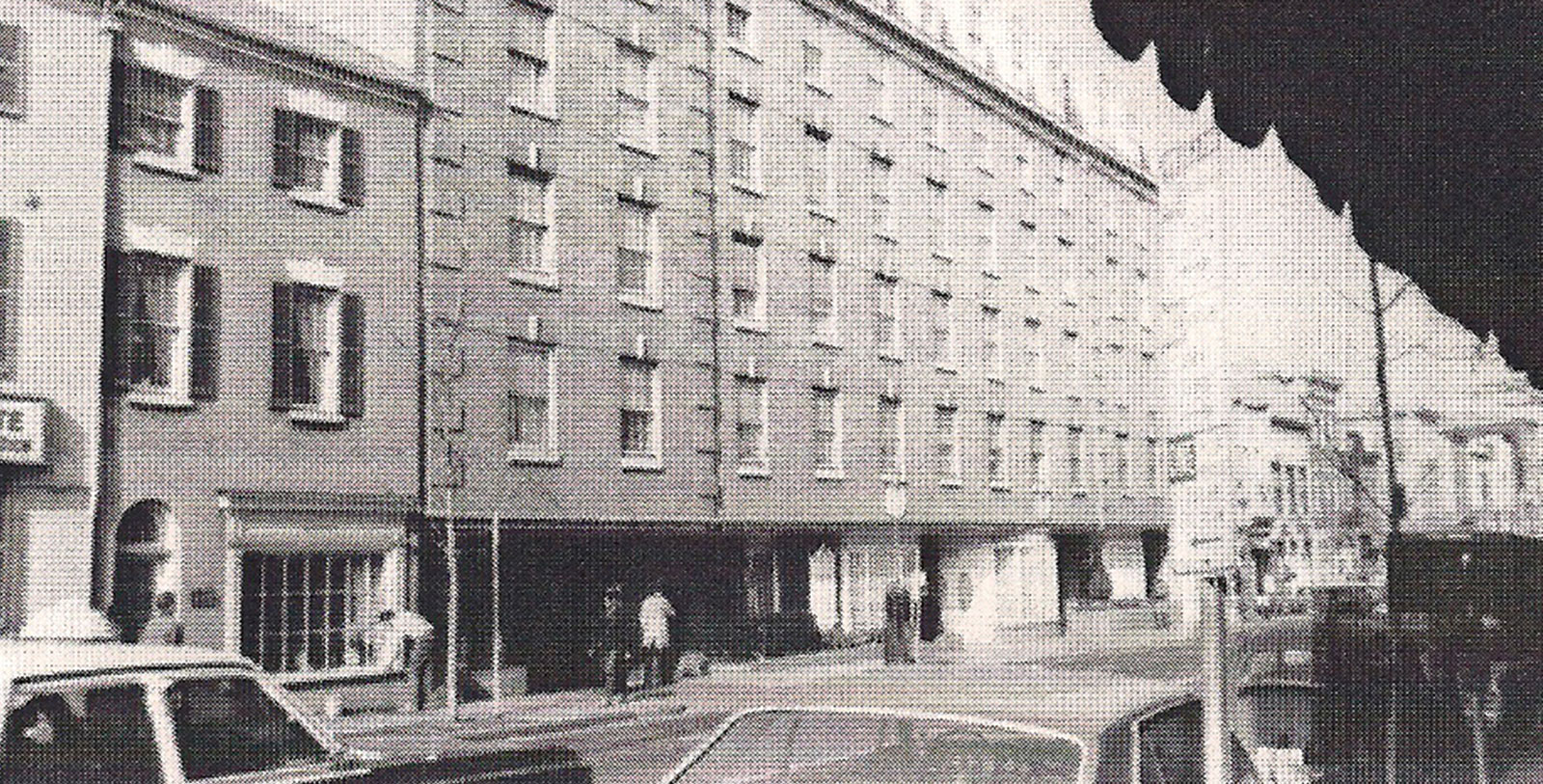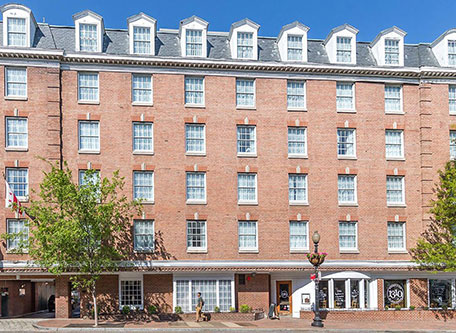Receive for Free - Discover & Explore eNewsletter monthly with advance notice of special offers, packages, and insider savings from 10% - 30% off Best Available Rates at selected hotels.
historic hotel in washington d.c.
Discover Georgetown Inn, which was the vision of Sheldon Magazine and the first new hotel in Georgetown in over one hundred years.
Georgetown Inn, a member of Historic Hotels of America since 2019, dates back to 1962.
VIEW TIMELINEIn 1959, the illustrious President of the American Mortgage Investment Company—Sheldon Magazine—boldly announced his intention to create an opulent hotel nestled within Washington’s historic Georgetown neighborhood. Magazine yearned for a grand establishment that could properly cater to the city’s teeming population of noteworthy visitors. Taking nearly three years to complete, Magazine’s glorious new venue debuted as the “Georgetown Inn” before an enthusiastic crowd on May 21, 1962. At the time of its opening, it was the first new hotel in Georgetown in over a century. With room rates starting at $22 a night, it was also the most expensive hotel in the city at the time. A massive, four-day-long party ensued to inaugurate the building, which culminated with a jovial toast of the finest champagne. For the next several decades, Georgetown Inn emerged as a prominent destination for the rich and famous. The first of many well-known international dignitaries to reside at the hotel were the Duke and Duchess of Windsor. The location also became a haunt for numerous Hollywood celebrities, such as Marlon Brando, Robert Mitchum, and Elizabeth Taylor. The hotel maintained this luxurious appeal under the supervision of its first General Manager, Collins Bird. A transplant from Georgia who hailed from a family of hoteliers, Bird quickly garnered a following among Georgetown Inn’s famous clientele for his brilliant temperament. Many of the hotel’s distinguished patrons, such as former United States Vice President Hubert Humphrey, sojourned to the location in large part to meet with its spirited innkeeper. A member of Historic Hotels of America since 2019, the Georgetown Inn remains a prominent destination in downtown Washington, D.C.
-
About the Location +
Georgetown Inn resides in the quaint neighborhood of Georgetown, which also happens to be one of the most historic in the District of Columbia. Indeed, the community predates Washington itself by about four decades! While Anacostia Native Americans had frequented the area for centuries, it was two European colonists named Niall Beall and George Gordon who created the first known permanent settlements. Beall originally arrived at the beginning of the 18th century, He had immigrated directly from Scotland and built a sprawling farmstead known as the “Rock of Dumbarton.” George Gordon then came four decades later to create his own estate, “Rock Creek Plantation.” Despite their presence, the colonial Maryland legislature eventually decided to construct an official town in the area. In 1751, the Maryland General Assembly enacted its plan and approved a commission to purchase some 60 acres from Beall and Gordon. The commissioners then spent the next several months parceling out the land into a street grid with 80 different lots. Settlers from across the Mid-Atlantic soon moved into the new community, which they called “Georgetown.” (No official record exists that explains the reason behind its name. Some scholars speculate that it was a homage to King George II of Great Britain, while others believe it honored George Gordon.) Driving the town’s growth was its proximity to the Potomac River and the maritime trade that it facilitated. Indeed, the town was soon filled with many wharves and warehouses that handled numerous agricultural goods from across the Mid-Atlantic region. Tobacco soon became the main crop ferried into Georgetown, which introduced unprecedented wealth into the community.
The Maryland General Assembly finally granted Georgetown its own communal charter in the wake of the American Revolution. But thanks to the efforts of President George Washington, the entire community was absorbed into the District of Columbia in 1791. (Washington had specifically engaged in numerous negotiations at a local haunt called “Suter’s Tavern.) Georgetown remained an autonomous jurisdiction within the territory for the next few decades, where it continued to be an important port. The debut of the historic Chesapeake and Ohio Canal in the early 19th century helped preserve this status, as it further augmented the ability of riverboat captains to transport their goods into the community. The prosperity also inspired Washington’s nascent political class to move into the town, as well. Despite its prestigious influence, Georgetown nonetheless lost its remaining independence revoked by Congress in 1871. Streets throughout the erstwhile town were gradually renamed in order to accommodate the preexisting ones that already existed in Washington proper. The demise of the canal marked the beginning of Georgetown’s gradual decline as a commercial port as well, although some heavy industry remained active for years thereafter. But Georgetown was still very much a desirable place to live among Washingtonians, especially among the city’s black population. In fact, Georgetown saw the development of a thriving African American community that endured well into the 20th century.
Today, the neighborhood continues to be a vibrant within greater Washington, D.C. Many politicians continue to choose the area as their primary residence in the city, as well as their favorite place to conduct business or just relax. Georgetown is also one of the most exciting places for tourists to visit, too, especially the country’s enthusiastic cultural heritage travelers. Not only is it listed as a U.S. National Historic Landmark District, but it is also home to a number of outstanding cultural institutions. Among the most noteworthy are Georgetown University, Georgetown Waterfront Park, the Old Stone House, the Dumbarton Oaks Museum, the Tudor Place Historic House & Garden, and the remnants of the once mighty Chesapeake & Ohio Canal. Georgetown’s location within Washington also places it close to many other fascinating destinations. Just to the north of Georgetown is the renowned Embassy Row and the Washington National Cathedral. Over to the east across Rock Creek resides Dupont Circle and the John F. Kennedy Center for the Performing Arts. The Lincoln Memorial and the White House are only a few more minutes deeper into the city, as are the Pennsylvania Avenue Historic Site, the Washington Monument, the National Mall, and the United States Capitol. And just across the river resides Arlington National Cemetery and the upscale community of Alexandria, Virginia. Truly few places in the District of Columbia can rival Georgetown with its rich history and accessible location.
-
About the Architecture +
The Georgetown Inn stands today as a wonderful interpretation of Colonial Revival architecture. Colonial Revival architecture itself is perhaps the most widely used building form in the entire United States today. It reached its zenith at the height of the Gilded Age, where countless Americans turned to the aesthetic to celebrate what they feared was America’s disappearing past. The movement came about in the aftermath of the Centennial International Exhibition of 1876, in which people from across the country traveled to Philadelphia, Pennsylvania, to commemorate the American Revolution. Many of the exhibitors chose to display cultural representations of 18th-century America, encouraging millions of people across the country to preserve the nation’s history. Architects were among those inspired, who looked to revitalize the design principles of colonial English and Dutch homes. This gradually gave way to a larger embrace of Georgian and Federal-style architecture, which focused exclusively on the country’s formative years. As such, structures built in the style of Colonial Revival architecture featured such components as pilasters, brickwork, and modest, double-hung windows. Symmetrical designs defined Colonial Revival-style façades, anchored by a central, pedimented front door and simplistic portico. Gable roofs typically topped the buildings, although hipped and gambrel forms were used, as well. This form remained immensely popular for years until largely petering out in the late 20th century. Nevertheless, architects today still rely upon Colonial Revival architecture, using the form to construct all kinds of residential buildings and commercial complexes. Many buildings constructed with Colonial Revival-style architecture are even identified as historical landmarks at the state level, and the U.S. Department of the Interior has even listed a few of them in the U.S. National Register of Historic Places.
-
Famous Historic Guests +
Marlon Brando, actor known for his roles in movies like The Godfather, Apocalypse Now, and A Streetcar Named Desire.
Robert Mitchum, actor known for his roles in such films like El Dorado, The Night of the Hunter, and Cape Fear.
Elizabeth Taylor, actress known for her roles in Cleopatra and The Taming of the Shrew.
Wallace Simpson, Duchess of Windsor
King Edward VIII of the United Kingdom (1936; abdicated and became the Duke of Windsor)
Hubert Humphrey, 38th Vice President of the United States (1965 – 1969)
































